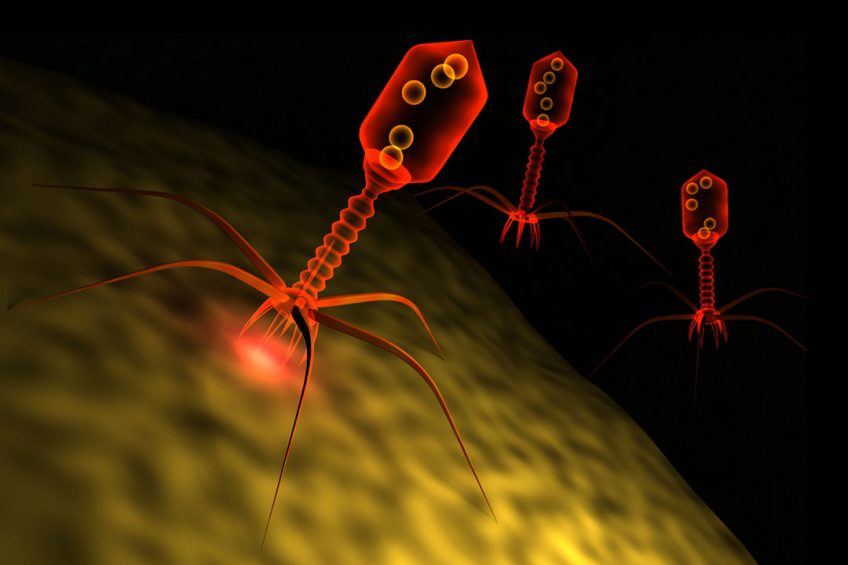Pros and cons of using phages

The world of health and nutrition is currently wondering how to tackle issues related to antibiotic resistance. The use of bacteriophages or enzybiotics might form a good alternative. What are they exactly, what are the pros and cons and most importantly – how can they be used?
Truly alarming, is how best to describe the most recent data about resistance to antibiotics for pathogenic bacteria. After all, they also affect the human health situation. It is estimated that per year, it is the cause of 25,000 human casualties in the European Union (EU) alone; worldwide, 700,000 lives are lost. In 2050, this tendency would lead to a situation where infection-related deaths will be more common than deaths as a result of cancer.
Apart from human losses, antibiotic resistance also represents an economic burden. Health spending in the EU because of resistance-related problems are estimated to cost € 1.5 billion. In that context, the European authorities have started up various programmes in an attempt to slow down the spread of harmful bacteria.
One Health action plan
The EU programme ‘One Health action plan against antimicrobial resistance’ has been created to coordinate and implement laws aimed at preventing and controlling the problem throughout all countries. In addition, the plan was designed to invigorate research and development into novel alternative therapeutic methods.
With regard to animal health, the problem has been particularly serious as a large number of zoonotic bacteria are causing infections in humans as well. On top of that, it is important to note that the indiscriminate usage of antibiotics in certain parts of the animal production industry has led to the development of resistant bacteria that can even be found in hospitals.
Any solution to this global problem, affecting various market segments (agribusiness, health care, environment), should be considered from various angles. That is why there is a plea for a reduction of the usage of antibiotics and disinfectants, which have to be substituted by other types of antimicrobial approaches that ideally will lead to a low frequency of resistant bacteria. Also, it should be key to find alternatives that one can use to fight multi-resistant bacteria.
Figure 1 – Illustration of the antimicrobial activity of bacteriophages.
Bacteriophages and enzybiotics
Bacteriophages or simply phages (see Figure 1) are viruses that exclusively infect bacteria. Within these bacteria, they replicate and produce new virus particles which are set free as soon as the bacteria either disintegrates or explodes. This capacity of being able to destroy bacteria makes phages powerful antimicrobials and exactly that characteristic could be exploited while treating various infectious diseases, i.e. by phage treatment.
This type of treatment was discovered by Felix d’Herelle at the beginning of the 20th century and it was used in Eastern Europe for many years until the usage of antibiotics became commonplace. Nevertheless, in Poland and the former Soviet Union, the usage of phages for antimicrobial purposes has continued. These days, more western nations are also looking more into the use of phages in an attempt to fight infections.
Enzybiotics are proteins (enzymes) with bactericidal activities. In the context of phage therapy, enzybiotics are proteins coded by phages. Enzybiotics are capable of destroying certain bacteria, when they are being added externally. The majority of the enzybiotics are endolysins, and are derived from phages. The specific function of these endolysins is to destroy the bacteria that is host to the phages, so newly created virus particles can be set free, once the multiplication cycle has been finished, see Figure 2.
Figure 2 – Illustration of antimicrobial activity of enzybiotics.
Current status of phage therapy
The number of studies about phage therapy is growing, indicating that more data will become available about phage and enzybiotic efficacy and safety, especially with regard to the elimination of pathogenic bacteria in human health, animal health or the environment.
Noteworthy is the significance of research by some, mostly US-based biotechnology-based companies, as they received permission for various products. These products can be used in different segments of the agribusiness production chain, from the treatment or prevention of disease in farm animals, to the disinfection of farm houses. The following applications are available in relation to agriculture.
- AgriPhage (Intralytix, USA) is a commercially available product which consists of a mixture of phages which are active against pathogenic bacteria for plants. Its goal is to fight certain diseases in plant crops (think of tomatoes and peppers).
- In the field of food, Listex P100 (Micreos, the Netherlands) is a product that combines six phages to get rid of Listeria monocytogenes in certain nutrients and in industrial facilities.
- With regard to animal health, Intralytix has developed phage preparations for the prevention and treatment of animal diseases, which includes farm animals as well as pets. They are commercially selling products against Salmonella (PLSV-1) and Clostridium perfringens (INT-401) to treat chickens.
- Other products, like ListShield, EcoShield, SalmoFresh and ShigaShield, active against L. monocytogenes and E. coli O157:H7, Salmonella and Shigella respectively, are being used as a prevention measure in animals to stop these bacteria from entering the food chain.
- In this context, it is good to add that also products have been developed for the disinfection of the skin of live animals prior to slaughter. These include Ecolicide PX (Intralytix) and BacWash (OmniLytics, USA).
- Last but not least, there are also products developed to avoid infection by pathogenic bacteria in pet food, like Ecolicide, SalmoLyse and LystPhage (Intralytix).
Pros and cons When suggesting a novel substance as an antimicrobial, an evaluation requires a comparison with existing methods regarding its pros and cons.
Antimicrobials derived from bacteriophages, however, do have a couple of disadvantages.
|
Perspectives for the future
The list could of course be expanded with applications for humans. It is clear, however, that these products just constitute a precedent for the use of new phage-based compounds as antimicrobials, with application in different sectors.
For a fact, one of the most important problems before commercialisation of these types of products is the lack of clear regulations for them in every country. For instance, the United States Department of Agriculture (USDA) and the US Food and Drug Administration (FDA) have approved various products for use in agribusiness. Nevertheless, the European Food Safety Authority (EFSA) has completed an evaluation of certain food preservatives, but has not found concluding data for its use in the European Union.
With respect to products for animal health, in the EU, none of these products has received approval at this moment. Constantly, more research points to the big potential in this sector. For that reason, it is essential to continue contributing necessary data, so authorities can understand the real value of their later use.
This article earlier appeared in the Spanish magazine Albéitar. It was reprinted with permission and cooperation of the authors and original publishers. References are available on request.














